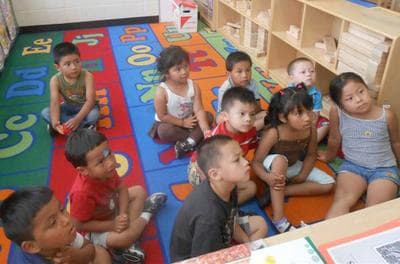Advertisement
Springfield's Head Start Fears Impact Of Sequester's Cuts
The early education program Head Start, one of the longest-running programs in the United States, is designed to address systemic poverty and provide quality early-childhood education to low-income families.

But as a result of the sequester's federal budget cuts, up to 70,000 fewer kids across the country could be enrolled in Head Start programs next year — including 1,600 preschool-age children in Massachusetts.
Springfield's Head Start
The western Massachusetts city of Springfield has the highest childhood poverty rate in the state. Gladys Rivera, a program director at Head Start here, offered a tour of the facility.
"We are at the lower level of our main office, where we have the three classrooms — two infant-and-toddlers, and one preschool classroom — so a total of 33 children in all," she said.
Springfield's is one of 29 Head Start programs in the state; it also serves families in nearby Holyoke and Chicopee — a total of 1,200 kids ranging in age from 6 months to 5 years.
Additionally, Rivera says Springfield is the only one that has a program specifically for the children of migrant workers who come to the area in spring and stay through summer to pick berries, tobacco and asparagus.
"And the children do arrive at 5:30 in the morning every single day; we provide transportation to each of the children," Rivera said. "So our staff actually began their day at 4:45." She added: "[Staff are] usually here close to 12 hours so it's a very long day for them."
Half the day the kids are taught in Spanish, half the day in English.
Advertisement
"We offer a day where they can have a breakfast, where they can have a lunch, where they can have engagement with other children and develop their social/emotional skills, to develop their reading skills so they can be proficient," Rivera said.
"We don't always look at it, OK, we have them until they're 5. We look at it, we want them to succeed in life and look at the big picture."
Head Start teaches parents, too, with lessons in nutrition, health, finance and job hunting. Immigration status isn't taken into account, but in order to qualify, a family of four has to have a household income of less than $23,000.
"If they need mental health, medical insurance, food, if they need clothes, we're very involved with that with the family to provide those services," explained Juanita Gomez, the Head Start family service coordinator.
Most kids in the Springfield Head Start program come from two-parent families.
"I know these parents work long hours," said lead teacher Paulet Garcia, who cares for the infants and toddlers. "So if they're not here, they might be at a babysitter's house, and we're not sure quite what they do with the babysitter, but I know the babysitter has a lot of children. Like one babysitter [has] probably eight-plus kids."
The Impact Of The Budget Cuts
The ratio in the infant-toddler program is two kids for each teacher. In the pre-K classes, it's three or four to a teacher. The cost is about $7,200 per child, per year.
Quality early childhood education quickly adds up. Last year the overall budget here was about $10 million. The sequester cut that by 5.27 percent, or more than $500,000.
Next year, the Springfield kids I met get to stay in Head Start, but come next July there'll be fewer spaces for new children in the migrant program, according to Rivera.
"Due to sequestration we needed to cut around 31 children," Rivera said. "So moving forward we're only going to be able to service 100 children. ... And of course that's affecting staffing too, so we're needing to eliminate staffing as well, which is unfortunate."
When the full force of sequestration hits, Springfield’s Head Start will have to cut more than 200 kids from its programs.
I ask: What about people who say these are migrants, and bristle at the thought of using taxpayer dollars for such a program?
"Ultimately, you look at this migrant population and the meaning that they do for this country," Rivera responded. "I don't think people really see that as meaningful. They put the food that we eat [on the table] and they're working in the fields and working with pesticides. And we take advantage of that."
When the full force of sequestration hits, Springfield's Head Start will have to cut more than 200 kids from its programs. That's more than 15 percent of the children it now serves. And that's just the first year of the decade-long cuts.
"When people ask me what I do, I say I fight for poor children every day," said Janis Santos, a legend in early child care education and a Head Start pioneer. She opened the Springfield program 40 years ago. It was the first in the state and one of the first in the nation.
She's still the executive director in Springfield.
"To get this cut to our program is very frustrating," Santos said, "and for the first time in my 40 years I don't quite understand it. It is so challenging. How do you tell families, 'I'm sorry, but we can't take your child this year'? But we're fighters, and all of the Head Starts in America, that's what we do; we fight for poor children each day. We want them to have a good education and a good quality of life."
It's estimated that for every $1 invested in Head Start, there are $7 in benefits later on: better-paying jobs for families and kids in the program, and savings, by breaking the social costs in the cycle of poverty.
This article was originally published on July 17, 2013.
This program aired on July 17, 2013.
